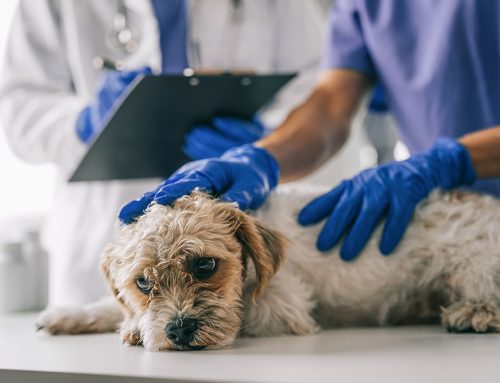Whether you are making a move, traveling for work, or taking a much needed vacation, you may need to take your pet. However, proper planning is essential to ensure that traveling with your pet is enjoyable. Our team at Wellness Animal Hospital wants to provide tips to ensure the experience is successful for you and your four-legged friend.
#1: Make a veterinary appointment
Before traveling, you want to ensure that your pet will have no health problems while on your trip. Pets have a natural instinct to hide vulnerability, and they commonly don’t exhibit illness signs until their condition is advanced. A veterinary professional’s thorough health examination and routine blood testing will ensure your pet is healthy enough for your upcoming travel.
#2: Ensure your pet is properly identified
If your pet goes missing while you are traveling, proper identification will increase their chances of being returned. Microchipping, which is a simple procedure that can easily be performed during a routine wellness visit, is the best permanent identification for your pet. Once the chip is implanted, your only responsibility is to register your pet online and keep your contact information updated in the registry’s database, so you can be located if your pet is found and their chip is scanned. Your pet should also always wear a collar and tags with your current contact information.
#3: Ensure your pet has the necessary paperwork
When traveling by air or across state lines, you will need a health certificate signed by an accredited veterinarian. This involves a veterinarian’s examination to ensure your pet is not exhibiting any contagious disease signs. Other considerations include:
- Necessary vaccines — Some air carriers and destinations require that your pet receives specific vaccinations at least 30 days prior to travel.
- Blood titers — Certain countries require a negative rabies titer—results can take two to three months, so ensure you make an appointment as soon as possible.
- Microchip — International Standards Organization (ISO) microchips are mandatory for international travel, to ensure the imported pet matches their vaccination history and health paperwork. We can scan your pet’s microchip to determine ISO compliance and implant an appropriate chip, if necessary.
- Regulations — Every country has different requirements, and our veterinary professionals can help you determine your needs, depending on your final destination. You can also research the USDA’s travel site to help prepare for your trip.
#4: Acclimate your pet to traveling
New experiences can be stressful for pets, who should be properly acclimatized before setting out for a long trip. This process takes at least a month, so don’t wait until the last minute to start practicing with your pet. Tips include:
- Acclimate them to their carrier — Leave their carrier out so they can get used to using the space as a safe zone.
- Introduce them to your car — Let them get used to spending time in your parked vehicle, providing toys and treats to make their experience positive.
- Crank the car — Once your pet seems comfortable in your car, crank the vehicle to allow them to acclimate to the noise and vibration.
- Take a short trip — Go for a five-minute drive, with someone riding in the backseat to comfort your pet during the ride. Practice riding with your pet every day, gradually increasing the trip length over several weeks.
#5: Research your accommodation’s pet policies
You don’t want to travel a long distance, only to discover your accommodation is not pet-friendly. Many locations don’t allow pets, while others do accept them, but have breed and weight restrictions. Review your accommodation’s pet policy in detail before booking your reservation, and call the establishment to ensure you have the most up to date information.
#6: Restrain your pet appropriately
Pets should always be restrained while traveling in a vehicle to ensure everyone’s safety. Proper restraint options include:
- Carriers — Small dogs and cats should travel in a carrier secured to the seat or placed on the floor. The carrier should be large enough for them to stand up, turn around, and lie down comfortably.
- Seat belt harness — Larger dogs should be secured with a properly fitted seat belt harness, and must be acclimated to the device before your trip.
- Pet barrier — You can also sequester your pet in your car’s back cargo area with a pet barrier.
#7: Prepare for a veterinary emergency
Locate reputable veterinary emergency clinics along your route and at your final destination to ensure you know where to go should your pet have a veterinary emergency. In addition, review your pet’s health insurance policy to ensure your pet will be covered in a different state or country.
#8: Pack a pet supply kit

To help ensure a successful trip, your pet will need certain supplies, including:
- Food — Pack enough food to ensure your pet is well fed during the trip. A sudden diet change can lead to gastrointestinal upset, which you definitely don’t want while traveling.
- Water — Pets can easily become dehydrated while traveling if they don’t have regular access to water. Stow plenty of water, and let your pet drink frequently.
- Bowls — Don’t forget bowls, so you can easily offer food and water.
- Medications — Ensure you bring your pet’s medications, including their monthly parasite preventive.
- Toys and treats — Ensure you bring toys to keep your pet occupied and treats to reward them for good behavior.
- Plastic bags — Pack plastic bags for cleaning up after your pet.
- Cleaning supplies — Supplies, such as wet wipes, paper towels, and disinfectants, are handy in case your pet has an accident.
- Litter — Your cat will need litter box access, extra litter, and a scoop to clean the box.
Following these tips will help you prepare for a fun and enjoyable trip with your pet. If you need your pet microchipped, or a health certificate, contact our team and schedule an appointment at Wellness Animal Hospital as soon as possible.







Leave A Comment